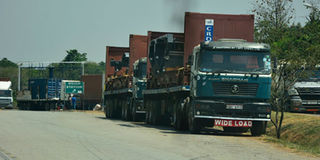Slow Internet affects e-clearance of cargo

Trucks of goods at Malaba weigh bridge. The electronic single window system is dependent on the Internet and poor network translates into no work. PHOTO BY DOMINIC BUKENYA
What you need to know:
- In November 2016, the Uganda Electronic Single Window – a paperless platform that electronically receives, verifies and clears international trade documentation was launched. Prosper Magazine’s Dorothy Nakaweesi talked to Mr Lino Criel Icila, the secretary general of Uganda Clearing Industry and Forwarding Association about the impact of this system on trade across East Africa.
In November 2016, the Uganda Electronic Single Window – a paperless platform that electronically receives, verifies and clears international trade documentation was launched. Prosper Magazine’s Dorothy Nakaweesi talked to Mr Lino Criel Icila, the secretary general of Uganda Clearing Industry and Forwarding Association about the impact of this system on trade across East Africa.
How has business been after introducing the Electronic Single Window?
The Uganda Electronic Single Window is a very good facility because it is a single platform where you log all trade information at once through one point. You can access all the relevant agencies involved in international trade clearance. It actually cuts down the process of clearance.
Once you have logged the documents, all the other agencies can access them. You can even apply for relevant certificates such as certificate of origin through this system. Single Window is also reducing human contact; thus, curbing corruption.
How many active members of UCIFA are using this system?
We have about 360 active members. Like I have told, you, some agencies have already joined the single window while others haven’t. As UCIFA, we are also just getting on to the system. For now, we access the single window indirectly through the Uganda Revenue Authority (URA) online portal. But even before we were able to access the entire system,.
Are your members conversant with using the Single Window?
They are aware but still need to be sensitised. Right now, they are accessing it from the URA system not directly through the one-point single window portal because we are at the early stage of usage.
How do you compare the pre-Electronic Single Window (manual clearing) period with the current period (electronic clearing)?
There is a big difference. First, there is a reduction in the time involved in cargo clearance by 30 per cent. The system is also cutting costs of handling cargo because the faster the clearance, the lesser costs involved. It is making clearance work very fast; thus enabling us get paid on time. Clearing Agents are paid when goods are delivered.
Any challenges encountered with the system so far?
We need to incorporate all the relevant agencies involved in international trade, to ensure all potential users are able to open up accounts, have their own passwords and manage their accounts.
Network connection is a major challenge. This system is dependent on the Internet and poor network translates into no work.
Uganda is depending on the Mombasa Route to clear goods. This has cost them money yet there is an alternative. In your view, is Tanzania a reliable alternative for cargo transportation?
Certainly yes! We are exploring that possibility. In this business, we must always have an alternative – option B. The challenge with Tanzania is the distance. Dar-es-Salaam is very far. Tanzania has also been having problems with their roads and connecting with Port Bell in case you are to using water transport.
We are happy when both Kenya and Tanzania have the infrastructure because it gives us an alternative in case of any emergency.



